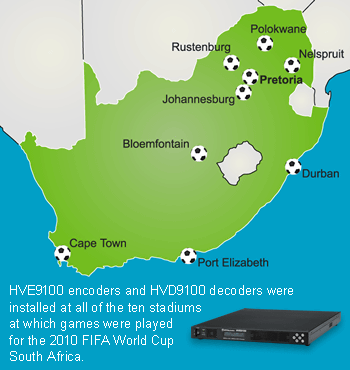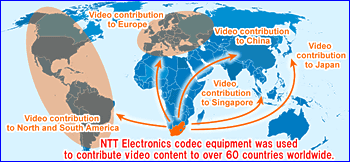NTT Electronics Codec Technology Used at the 2010 FIFA World Cup South Africa
August 30, 2010
Codec equipment installed at all ten stadiums to contribute video to the IBC in Johannesburg via satellite communications
NTT Electronics HV9100 Series AVC/H.264 HDTV/SDTV encoder/decoders were installed at all of the ten stadiums in the Republic of South Africa at which games were held for the 2010 FIFA World Cup to contribute video from the stadiums to the IBC( *1 ).
Compatible with high bitrate encoding, the highly rated HV9100 Series enables video transmission in low latency and supports the High 4:2:2 Profile( *2 ) format, making it ideal for the transmission of high-quality images even for soccer games marked by fast-moving action. It was for this reason that it was chosen as the codec equipment to be used for high-definition coverage of the World Cup.
Video contribution from stadiums to the IBC. The transmission of non-compressed images via Telkom’s optical fiber cables was used as the main transmission system for the 2010 FIFA World Cup. The transmission of images, which were AVC/H.264-encoded using the HV9100 Series, via Sentech’s satellite communications was used as a backup system. Although the HV9100 Series was positioned as a backup system, video transmitted by this series to the IBC was used by many broadcasting stations as the primary source for their broadcasting programs.
- *1
- The IBC is a broadcasting centre installed at the venue of international events such as the FIFA World Cup soccer tournament and the Olympic Games. Equipped with studios and transmission equipment, the IBC is occupied by broadcasting stations from around the world that hold the broadcasting rights for the relevant event.
- *2
- Click here for an explanation of the difference in picture quality between the High 4:2:2 Profile and High Profile formats.

The HV9100 Series was installed at all of the ten stadiums at which games were played for the 2010 FIFA World Cup South Africa.
Note: The games were played at ten stadiums in nine cities because Johannesburg has two stadiums.

The HV9100 Series was used for the transmission of video from all ten stadiums to the IBC via satellite communications, contributing to the transmission of high-quality images in low latency.
Used by over 20 companies, the more than 100 codec systems demonstrated their worth at the IBC
The use of NTT Electronics codec equipment was not limited to contributing video from each stadium to the IBC; a total of more than 100 NTT Electronics codec systems were used by over 20 communications carriers and broadcasting stations that had located their bases for coverage of the event at the IBC. These codec systems contributed to video transmissions from South Africa to more than 60 countries worldwide.
With its codec systems being used by distinguished communications carriers and broadcasting stations such as the European Broadcasting Union (EBU), the world’s largest association of national broadcasters, and China Central Television (CCTV), one of the largest state-owned TV stations in China, NTT Electronics provided on-site technical services that ensured the successful broadcast of all of the games that were played during the 2010 FIFA World Cup.

NTT Electronics codec equipment contributed to the video transmission of the hard-fought games played in South Africa to over 60 countries worldwide.
NTT Electronics codec equipment was used to contribute video to over 60 countries worldwide.
Going forward, NTT Electronics will continue to upgrade its real-time transmission technology, bringing excitement to a wide range of viewers.
The 2010 FIFA World Cup soccer tournament saw a number of dramatic events unfold, and the events witnessed at South Africa's stadiums left a deep impression on innumerable viewers across the world. NTT Electronics is delighted that its codec equipment contributed to the broadcasting of games to more than 60 countries worldwide, bringing excitement to viewers of the World Cup.
The Olympic Games and the FIFA World Cup are always the first to be mentioned as global sporting events. With the FIFA World Cup said to attract even more viewers than the Olympic Games, NTT Electronics codec systems had to provide a high level of performance and reliability in the broadcasting of World Cup games so as to ensure that the broadcasts were of a high level and mistake free. These systems were used by more than 20 communications carriers and broadcasting stations from around the world during the tournament, demonstrating the high quality of NTT Electronics products.
These codec systems not only transmitted images of soccer games marked by fast-moving action, which are extremely difficult for codec systems to process, but also reproduced the green turf of the pitch beautifully, offering extremely realistic images of the games to the audience. The transmission of images in low-latency mode, which enabled the fastest possible transmission of goal scenes, was also well received.
Going forward, NTT Electronics will continue to upgrade its real-time transmission technology, bringing excitement to a wide range of viewers.
Shoichi Nakano
General Manager
Overseas Systems Business Division